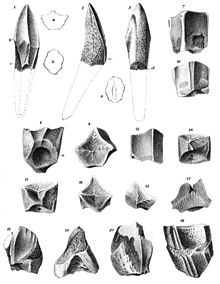
Back Trachodon Catalan Trachodon Czech Trachodon mirabilis Spanish טרכודון HE Trachodon Hungarian Trachodon Italian トラコドン Japanese 트라코돈 Korean Trachodon Dutch Trachodon Polish
| Trachodon Temporal range: Late Cretaceous,
| |
|---|---|

| |
| Illustration of the isolated teeth | |
| Scientific classification | |
| Domain: | Eukaryota |
| Kingdom: | Animalia |
| Phylum: | Chordata |
| Clade: | Dinosauria |
| Clade: | †Ornithischia |
| Clade: | †Neornithischia |
| Clade: | †Ornithopoda |
| Family: | †Hadrosauridae |
| Genus: | †Trachodon Leidy, 1856 |
| Species: | †T. mirabilis
|
| Binomial name | |
| †Trachodon mirabilis Leidy, 1856
| |
| Synonyms | |
| |
Trachodon (meaning "rough tooth") is a dubious genus of hadrosaurid dinosaur based on teeth from the Campanian-age Upper Cretaceous Judith River Formation of Montana, U.S.[1] It is a historically important genus with a convoluted taxonomy that has been all but abandoned by modern dinosaur paleontologists.[2]
Despite being used for decades as the iconic duckbill dinosaur, the material it is based on is composed of teeth from both duckbills and ceratopsids (their teeth have a distinctive double root[3]), and its describer, Joseph Leidy, came to recognize the difference and suggested limiting the genus to what would now be seen as ceratopsid teeth.[2] Restricted to the duckbill teeth, it may have been a lambeosaurine.[4]
- ^ Leidy, J. (1856). "Notice of remains of extinct reptiles and fishes, discovered by F. V. Hayden in the Bad Lands of the Judith River, Nebraska Territories." Proceedings of the Academy of Natural Science Philadelphia, 8(25 March): 72–73.
- ^ a b Creisler, B.S. (2007). Deciphering duckbills. in: K. Carpenter (ed.), Horns and Beaks: Ceratopsian and Ornithopod Dinosaurs. Indiana University Press: Bloomington and Indianapolis, 185–210. ISBN 0-253-34817-X
- ^ Hatcher, J.B., Marsh, O.C. and Lull, R.S. (1907). The Ceratopsia. Government Printing Office, Washington, D.C., 300 pp. ISBN 0-405-12713-8
- ^ Sternberg, C.M. (1936). The systematic position of Trachodon. Journal of Paleontology 10(7):652–655.
© MMXXIII Rich X Search. We shall prevail. All rights reserved. Rich X Search